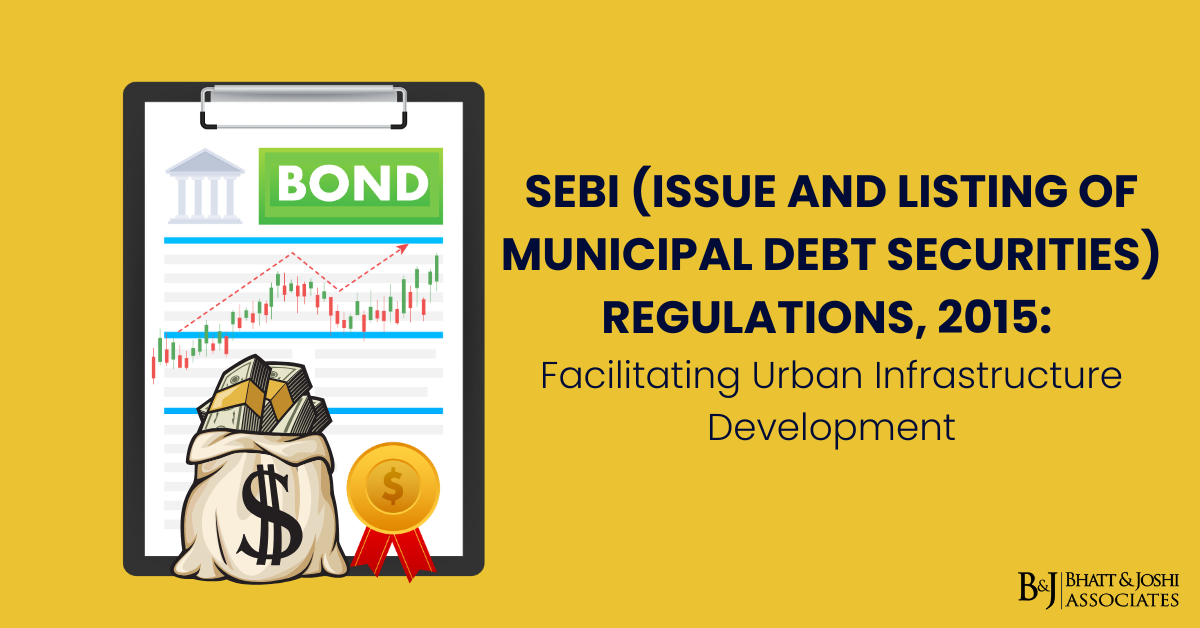Introduction
The Securities and Exchange Board of India (SEBI) introduced the Issue and Listing of Municipal Debt Securities Regulations in 2015 to establish a comprehensive regulatory framework for municipalities to access the capital markets through municipal bonds. These regulations emerged as part of a broader policy initiative to address the massive infrastructure funding gap faced by Indian urban local bodies (ULBs) and to diversify their sources of finance beyond traditional government grants and financial institution loans. By creating a structured pathway for municipalities to tap the debt capital markets, SEBI aimed to not only enhance municipal financial autonomy but also deepen India’s corporate bond market by introducing a new class of issuers and instruments with characteristics distinct from corporate bonds.
History & Legislative Evolution of SEBI Municipal Debt Regulations
The introduction of these regulations in 2015 represented a significant milestone in the evolution of municipal finance in India. While municipal bonds had theoretically been possible since the 1990s, with Ahmedabad Municipal Corporation issuing the first municipal bond in 1998, the absence of a specialized regulatory framework had limited market development. The few municipal bonds issued prior to these regulations were structured as private placements or with substantial credit enhancements that essentially transformed their risk profile to that of the enhancing entity rather than the municipality itself.
The regulatory framework emerged from the recommendations of the High-Powered Expert Committee on Urban Infrastructure, which identified municipal bond markets as a critical missing element in India’s urban financing landscape. This coincided with the launch of ambitious urban renewal missions such as the Smart Cities Mission and AMRUT (Atal Mission for Rejuvenation and Urban Transformation), which required substantial capital investments beyond traditional funding sources.
The regulations were promulgated under Section 30 of the SEBI Act, 1992, which empowers SEBI to make regulations consistent with the Act. Subsequent amendments in 2019 and 2021 further refined this framework, responding to early implementation experiences and stakeholder feedback. These amendments particularly focused on easing disclosure requirements while maintaining investor protection standards and introducing more flexibility in the use of proceeds.
Eligibility Requirements for Municipal Issuers
Regulation 4: Core Eligibility Criteria
Regulation 4 establishes the fundamental eligibility requirements for municipalities seeking to issue municipal debt securities:
“No issuer shall make any public issue of municipal debt securities unless: (a) the municipality has surplus income as per its income and expenditure statement in any of the immediately preceding three financial years or any other financial criteria as may be specified by the Board from time to time; (b) the municipality has not defaulted in repayment of debt securities or loans obtained from banks or financial institutions during the last three hundred and sixty-five days; (c) no order or direction of restraint, prohibition or debarment by the Board against the corporate municipal entity or its directors or the municipality, as may be applicable, is in force; (d) the issuer, its directors, promoters or the municipality shall not have been referred to in the list of the wilful defaulters published by the Reserve Bank of India or at the Credit Information Bureau India Limited; (e) an issuer or its promoter or directors have not been convicted of any offence connected with any matter pertaining to the securities market or any other economic offences.”
These provisions ensure that only financially sound municipalities with established track records of fiscal responsibility can access the capital markets. The requirement for surplus income in recent years serves as a basic financial health indicator, while the absence of recent defaults establishes creditworthiness. The additional integrity requirements regarding willful defaults and securities market offenses align municipal issuers with standards applicable to corporate issuers.
Corporate Municipal Entities
An innovative feature of the regulations is the provision for “corporate municipal entities” (CMEs) – specialized corporate vehicles established by municipalities for issuing debt securities. Regulation 2(1)(d) defines a CME as:
“a company as defined under the Companies Act, 2013 which is a subsidiary of a municipality and which is incorporated for the purpose of raising funds for a specific municipality or group of municipalities.”
This structure allows municipalities to create dedicated issuance vehicles with corporate governance structures, potentially enhancing investor confidence while maintaining the municipal connection through ownership. The regulations impose additional requirements on CMEs, including:
- A minimum 51% municipal ownership
- Exclusive focus on municipal projects
- Dedicated escrow mechanisms for project revenues
- Enhanced disclosure regarding the municipal parent
This dual approach – allowing either direct municipal issuance or issuance through a CME – creates flexibility for structuring municipal bond offerings according to local conditions and investor preferences.
General Obligations and Disclosure Requirements
Chapter II: Core Obligations for Municipal Issuers
Chapter II establishes fundamental obligations for municipal issuers. Regulation 13 mandates comprehensive disclosure in the offer document:
“The offer document shall contain all material disclosures which are necessary for the subscribers of the municipal debt securities to take an informed investment decision.”
Regulation 14 outlines specific disclosure requirements, including:
- Details of project(s) to be financed
- Statement of assets and liabilities
- Revenue sources and major expenditure heads
- Property tax collection figures for three years
- Outstanding borrowings and repayment track record
- Credit rating and rationale
- Borrowing limits and compliance status
- Details of escrow mechanisms and payment structures
- Legal proceedings material to financial conditions
- Risk factors specific to the municipality and projects
These disclosure requirements reflect the unique characteristics of municipal issuers, focusing on fiscal health indicators relevant to local governments rather than corporate metrics. The emphasis on property tax collection efficiency recognizes this revenue source as a fundamental indicator of municipal financial management capability.
Ongoing Disclosure Obligations in Municipal Debt
The regulations establish ongoing disclosure obligations through Regulation 15:
“The issuer shall prepare and submit unaudited financial results on a half yearly basis to the stock exchange and debenture trustee, if any, within forty-five days from the end of the half year.”
Additionally, annual audited financial results must be submitted within sixty days from the financial year end. These provisions create transparency comparable to corporate issuers while recognizing the different reporting cycles of municipal entities.
Regulation 15(3) further requires immediate disclosure of material events, including:
- Any major change in revenue streams
- Change in credit rating
- Any addition or deletion of guarantor
- Any default in repayment obligations
- Any significant structural change in the municipality
These continuous disclosure requirements ensure investors remain informed about material developments throughout the life of the debt securities.
Project-specific Accounting and Escrow Mechanisms
Regulation 16: Financial Safeguards
A distinctive feature of the municipal debt regulatory framework is the emphasis on project-specific financial management. Regulation 16 states:
“(1) The issuer shall maintain separate accounts for projects or separate escrow accounts for servicing of municipal debt securities. (2) The issuer shall appoint a monitoring agency to monitor the escrow account for municipal debt securities or project implementation.”
This provision reflects the project-focused nature of municipal bonds in the Indian context, contrasting with general obligation bonds common in developed markets. The escrow mechanism creates a direct link between project revenues and debt service obligations, providing additional security to investors.
The monitoring agency requirement adds another layer of oversight, typically performed by an independent financial institution that verifies the proper utilization of funds and adherence to project timelines. This agency submits quarterly reports to the debenture trustee, creating ongoing transparency regarding project implementation and fund utilization.
Listing Requirements for Municipal Debt Securities under SEBI
Chapter IV: Market Access Framework
Chapter IV establishes requirements for listing municipal debt securities on recognized stock exchanges. Regulation 20 states:
“An issuer may list its municipal debt securities issued on private placement basis on a recognized stock exchange subject to the following conditions: (a) the issuer has issued such debt securities in compliance with the provisions of the Companies Act, 2013, rules prescribed thereunder and other applicable laws; (b) the issuer has made disclosures as specified in Schedule I of these regulations; (c) credit rating has been obtained in respect of such municipal debt securities from at least one credit rating agency registered with the Board; (d) the municipal debt securities are of the minimum face value of ten lakh rupees; (e) the revenue sources to service such debt is from a project which has completed at least 75% of the implementation status of such project.”
These provisions establish more flexible requirements for privately placed issues compared to public offerings, while maintaining essential investor protection through credit rating requirements and minimum denomination restrictions. The 75% project completion requirement for revenue-based securities reflects a risk management approach, ensuring that projects have substantially progressed before relying on their revenues for debt service.
Key Judicial Interpretations for Municipal Debt Securities Regulations
Pune Municipal Corporation v. SEBI (2018)
This SAT appeal addressed the interpretation of disclosure requirements for municipal issuers. Pune Municipal Corporation had challenged SEBI’s order regarding certain disclosure deficiencies in its bond offering. The tribunal’s judgment established:
“While municipal issuers have operational characteristics distinct from corporate entities, the fundamental principles of securities market disclosure apply with equal force. The disclosure standard under Regulation 14 must be interpreted purposively to ensure that investors receive all information material to their investment decision, including: (a) complete revenue sources and their sustainability; (b) competing claims on those revenues; (c) historical collection efficiency trends; and (d) material contingent liabilities.
The determination of materiality must consider the specific context of municipal finance, but cannot be less rigorous than for corporate issuers. The disclosure obligation extends beyond mere technical compliance with the enumerated requirements to encompass the substantive goal of investor protection through comprehensive information.”
This judgment affirmed that while disclosure requirements are tailored to municipal contexts, they maintain the same fundamental investor protection objectives as corporate disclosure frameworks.
Greater Hyderabad Municipal Corporation v. SEBI (2019)
This case addressed the use of proceeds requirements and change management. Greater Hyderabad Municipal Corporation had proposed diverting certain bond proceeds to projects not specifically disclosed in the offer document. The SAT judgment noted:
“The specificity of use of proceeds disclosure under Regulation 14(d)(ii) creates a binding commitment to investors regarding the allocation of their funds. Unlike general corporate bonds where use of proceeds may be stated broadly, municipal debt securities in the Indian regulatory framework are project-specific instruments whose investment thesis is tied to particular infrastructure developments.
A municipality seeking to modify the use of proceeds must: (a) demonstrate substantial similarity in project type and risk profile; (b) obtain necessary approvals from bondholders as per trust deed provisions; (c) ensure continued compliance with financial covenants; and (d) provide detailed disclosure regarding the rationale and impact of the change.
The purpose-driven nature of municipal bonds creates a higher standard for use of proceeds discipline than might apply to general corporate debt.”
This judgment established important parameters regarding the modification of project funding allocations, emphasizing the project-specific nature of Indian municipal bonds.
Market Challenges and Regulatory Responses in Municipal Bonds
The municipal bond market has developed more slowly than anticipated despite the regulatory framework. Several challenges have emerged:
Credit Quality and Financial Reporting Standards
Many municipalities struggle to meet the financial eligibility criteria due to weak fiscal positions and limited revenue autonomy. Additionally, inconsistent accounting practices and delayed audits create transparency challenges for potential investors. SEBI has addressed these issues through:
- Coordination with the Ministry of Housing and Urban Affairs to promote standardized municipal accounting
- Encouraging credit enhancement mechanisms, including partial guarantees
- Promoting pooled financing structures for smaller municipalities
- Supporting capacity building initiatives through market participants
Market Awareness and Investor Base
The municipal bond market faces challenges in attracting institutional investors due to limited familiarity with this asset class. SEBI has responded through:
- Inclusion of municipal bonds as eligible securities for various investor categories
- Promotion of dedicated infrastructure debt funds that can invest in municipal securities
- Market education initiatives targeting institutional investors
- Encouraging retail participation through aggregation platforms
Structural Innovations
Regulatory adaptations have supported structural innovations to address market challenges:
- Revenue bonds tied to specific income streams rather than general municipal revenues
- Pooled finance development funds aggregating multiple smaller municipalities
- Hybrid structures combining municipal backing with credit enhancements
- Green municipal bonds for environmentally sustainable infrastructure
These innovations have been supported through interpretive guidance clarifying how the regulatory framework applies to these structures.
Comparative Analysis with Global Municipal Bond Markets
The Indian municipal bond regulatory framework differs from established markets like the United States in several respects:
- Project-specific focus rather than general obligation bonds
- Central regulatory oversight rather than self-regulation
- Mandatory credit rating requirements
- Stronger escrow and monitoring mechanisms
- More prescriptive disclosure requirements
These differences reflect India’s specific institutional context, including the evolving nature of municipal fiscal autonomy and the need for enhanced investor protection in an emerging market context. However, the framework incorporates global best practices regarding transparency, investor protection, and market integrity.
Recent amendments have moved toward greater alignment with international practices by:
- Reducing minimum tenure requirements to allow more flexible issuance
- Expanding eligible project categories to include refinancing of existing infrastructure
- Streamlining disclosure requirements for subsequent issuances
- Facilitating green bond issuances through specialized disclosure frameworks
Future SEBI Regulatory Directions for Municipal Debt Markets
The regulatory framework continues to evolve to address emerging challenges and opportunities:
Digital Transformation
Recent SEBI consultations have explored the integration of technology in municipal bond issuance and trading:
- Blockchain-based municipal bond registries
- Digital platforms for retail investor participation
- Automated compliance monitoring systems
- Standardized data reporting formats for comparative analysis
These innovations aim to reduce issuance costs and enhance market accessibility.
Integration with Urban Governance Reforms
The effectiveness of the municipal bond framework increasingly depends on broader urban governance reforms:
- Enhanced revenue autonomy for municipalities
- Professionalization of municipal financial management
- Improved urban master planning linking spatial development to financing needs
- Performance-linked incentives connecting bond market access to governance improvements
SEBI has engaged with urban policy stakeholders to ensure regulatory alignment with these broader reform initiatives.
ESG Integration
Environmental, Social, and Governance (ESG) considerations are increasingly relevant to municipal finance:
- Green municipal bond guidelines for climate-resilient infrastructure
- Social impact disclosure frameworks for municipal projects
- Enhanced governance disclosure requirements
- Alignment with national climate commitments and SDG targets
Recent regulatory guidance has clarified how these considerations integrate with the existing disclosure framework.
Conclusion
The SEBI (Issue and Listing of Municipal Debt Securities) Regulations, 2015, represent a significant advancement in India’s municipal finance landscape by creating a structured pathway for urban local bodies to access capital markets. The regulations establish a comprehensive framework addressing the unique characteristics of municipal issuers while maintaining core investor protection principles.
While market development has been gradual, the regulatory architecture has demonstrated flexibility through amendments and interpretive guidance responding to implementation challenges. The project-specific focus, enhanced disclosure requirements, and monitoring mechanisms create a distinctive approach to municipal bond regulation tailored to India’s institutional context.
As India continues its rapid urbanization, municipal bonds will likely play an increasingly important role in financing sustainable urban infrastructure. The regulatory framework established by these regulations provides the foundation for this market development while ensuring that municipal borrowing occurs within a prudent fiscal framework that protects both investor interests and municipal fiscal sustainability.
The evolution of this regulatory framework reflects SEBI’s broader approach to market development – balancing the need for innovation and access with appropriate safeguards reflecting the specific risk characteristics of each market segment. As municipalities gain experience with market financing and investors become more familiar with this asset class, the municipal bond market can contribute significantly to addressing India’s urban infrastructure deficit while deepening its capital markets.
References
- Agrawal, R., & Singh, V. (2020). Municipal Bonds in India: Regulatory Framework and Market Development Challenges. Journal of Securities Market, 18(2), 67-84.
- Bandyopadhyay, S., & Rao, M. G. (2018). Fiscal Health of Selected Indian Cities. Economic and Political Weekly, 53(36), 55-63.
- Chattopadhyay, S. (2021). Municipal Finance in India: Challenges and Opportunities. Indian Journal of Public Administration, 67(1), 41-57.
- Greater Hyderabad Municipal Corporation v. SEBI, Appeal No. 132 of 2019, Securities Appellate Tribunal (October 15, 2019).
- Kumar, T. S. (2019). Municipal Bond Market in India: An Analysis of Recent Developments. Reserve Bank of India Occasional Papers, 40(1), 51-68.
- Ministry of Housing and Urban Affairs. (2017). Municipal Bonds in India: A Primer. Government of India, New Delhi.
- Prasad, R., & Sinha, A. (2022). Financing Urban Infrastructure in India: Challenges and Innovations. Journal of Infrastructure Development, 14(1), 23-42.
- Pune Municipal Corporation v. SEBI, Appeal No. 256 of 2018, Securities Appellate Tribunal (July 30, 2018).
- Rao, M. G., & Bird, R. M. (2018). Special Fiscal Zones and Urban Infrastructure Finance. International Center for Public Policy Working Paper 18-10.
- Securities and Exchange Board of India. (2015). SEBI (Issue and Listing of Municipal Debt Securities) Regulations, 2015. Gazette of India, Part III, Section 4.
- Securities and Exchange Board of India. (2019). Amendment to SEBI (Issue and Listing of Municipal Debt Securities) Regulations, 2015. SEBI/LAD-NRO/GN/2019/43.
- Securities and Exchange Board of India. (2021). Consultation Paper on Review of SEBI (Issue and Listing of Municipal Debt Securities) Regulations, 2015. SEBI/HO/DDHS/CIR/P/2021/25.
- Singh, C., & Malik, S. (2017). Municipal Bonds as a Source of Finance for Urban Infrastructure Development in India. Indian Institute of Management Bangalore Working Paper No. 526.
- World Bank. (2020). Developing a Municipal Borrowing Framework: Lessons from International Experience. World Bank Group, Washington, DC.














